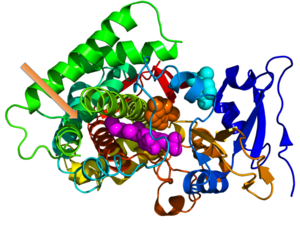
Protein moonlighting is a phenomenon by which a protein can perform more than one function.[2] It is an excellent example of gene sharing.[3]
Ancestral moonlighting proteins originally possessed a single function but, through evolution, acquired additional functions. Many proteins that moonlight are enzymes; others are receptors, ion channels or chaperones. The most common primary function of moonlighting proteins is enzymatic catalysis, but these enzymes have acquired secondary non-enzymatic roles. Some examples of functions of moonlighting proteins secondary to catalysis include signal transduction, transcriptional regulation, apoptosis, motility, and structural.[4]
Protein moonlighting occurs widely in nature.[5][6][7] Protein moonlighting through gene sharing differs from the use of a single gene to generate different proteins by alternative RNA splicing, DNA rearrangement, or post-translational processing. It is also different from the multifunctionality of the protein, in which the protein has multiple domains, each serving a different function. Protein moonlighting by gene sharing means that a gene may acquire and maintain a second function without gene duplication and without loss of the primary function. Such genes are under two or more entirely different selective constraints.[8]
Various techniques have been used to reveal moonlighting functions in proteins. The detection of a protein in unexpected locations within cells, cell types, or tissues may suggest that a protein has a moonlighting function. Furthermore, the sequence or structure homology of a protein may be used to infer both primary functions as well as secondary moonlighting functions of a protein.
The most well-studied examples of gene sharing are crystallins. These proteins, when expressed at low levels in many tissues function as enzymes, but when expressed at high levels in eye tissue, become densely packed and thus form lenses. While the recognition of gene sharing is relatively recent—the term was coined in 1988, after crystallins in chickens and ducks were found to be identical to separately identified enzymes—recent studies have found many examples throughout the living world. Joram Piatigorsky has suggested that many or all proteins exhibit gene sharing to some extent, and that gene sharing is a key aspect of molecular evolution.[9]: 1–7 The genes encoding crystallins must maintain sequences for catalytic function and transparency maintenance function.[8]
Inappropriate moonlighting is a contributing factor in some genetic diseases, and moonlighting provides a possible mechanism by which bacteria may become resistant to antibiotics.[10]
- ^ Cite error: The named reference
Zhao_2009was invoked but never defined (see the help page). - ^ Cite error: The named reference
Jeffery_2003was invoked but never defined (see the help page). - ^ Jeffery, Constance J (January 2003). "Multifunctional proteins: examples of gene sharing". Annals of Medicine. 35 (1): 28–35. doi:10.1080/07853890310004101. ISSN 0785-3890. PMID 12693610. S2CID 42033757.
- ^ Cite error: The named reference
Sriram_2005was invoked but never defined (see the help page). - ^ Jia, Baolei; Cheong, Gang-Won; Zhang, Shihong (2013-03-01). "Multifunctional enzymes in archaea: promiscuity and moonlight". Extremophiles. 17 (2): 193–203. doi:10.1007/s00792-012-0509-1. ISSN 1433-4909. PMID 23283522. S2CID 254082728.
- ^ Su, Bo; Qian, Zhuang; Li, Tianshu; Zhou, Yuwei; Wong, Aloysius (2019-04-25). "PlantMP: a database for moonlighting plant proteins". Database: The Journal of Biological Databases and Curation. 2019: baz050. doi:10.1093/database/baz050. ISSN 1758-0463. PMC 6482322. PMID 31032837.
- ^ Arvizu-Rubio, Verania J.; García-Carnero, Laura C.; Mora-Montes, Héctor Manuel (2022-09-13). "Moonlighting proteins in medically relevant fungi". PeerJ. 10: e14001. doi:10.7717/peerj.14001. ISSN 2167-8359. PMC 9480056. PMID 36117533.
- ^ a b Cite error: The named reference
Piatigorsky_1989was invoked but never defined (see the help page). - ^ Cite error: The named reference
Piatigorsky_2007was invoked but never defined (see the help page). - ^ Cite error: The named reference
Sengupta_2008was invoked but never defined (see the help page).